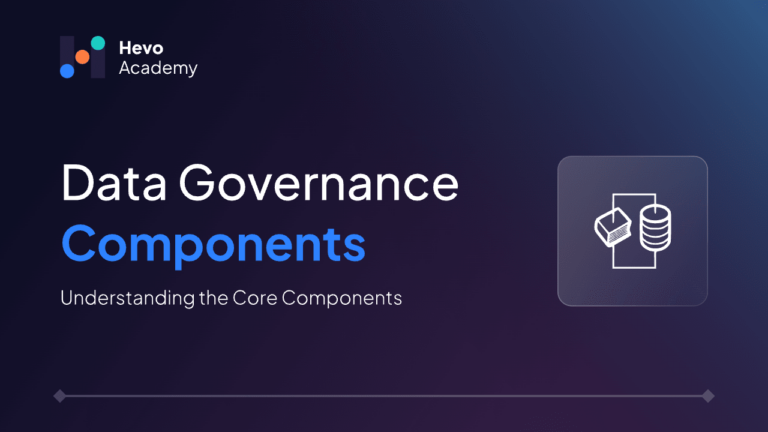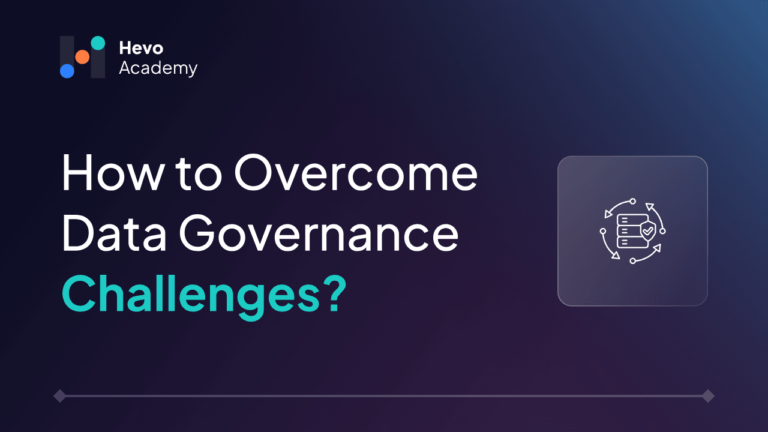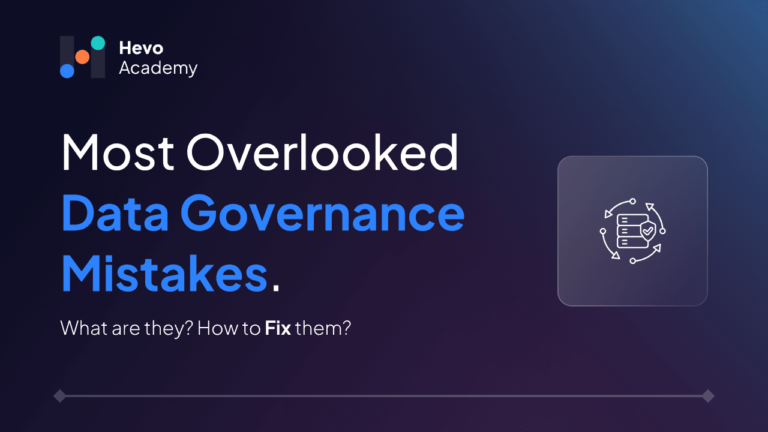Data is essential for any organization, so data governance cannot be overlooked. Data governance ensures that data used for business operations, analysis, and reports is accurate, trustworthy, and well-protected. It also guarantees that the data being utilized complies with legislation. This article discusses some of the essential data governance components for successful governance. These components help with effective data management, quality, and security.
Table of Contents
Hevo Data empowers your data governance strategy by automating data integration while ensuring compliance, data lineage, and consistency.
With Hevo, you can easily enforce data quality standards across multiple sources and streamline governance processes without writing a single line of code.
Take control of your data governance—schedule a personalized demo with Hevo today!
Get Started with Hevo for FreeWhat are Data Governance Components?
Data governance consists of components that help establish its framework. This article explains some of these components.
The Key Components of Data Governance
Some of the key components of data governance include:
1. Data Governance Strategy
The objectives of a data governance program should be defined. These objectives should be aligned with strategic business objectives. The strategy also includes targets to be reached to monitor progress and success metrics. The data governance strategy should also include business cases that describe the impact of ungoverned data on business. This allows for systematically identifying candidate business cases.
2. Data Governance Roles and Responsibilities
Many individuals participate in the data governance frameworks in most organizations. Business leaders, data management specialists, IT personnel, and end users who are conversant with relevant information fields within a company’s systems are all involved. Some of the roles include data owners, data custodians, data protection officers, data security teams, and data management officers.
3. Data Governance Policies
Data governance policies help ensure that data is managed in compliance with applicable laws. Established standards and guidelines govern data management practices within organizations. Policies for data quality serve as recommendations to guarantee that the data is correct, complete, and consistent. They outline techniques for resolving and correcting data discrepancies.
4. Data Quality Management
Data quality management includes processes and methodologies to maintain and improve data completeness, consistency and accuracy. This ensures that data is suitable for effective data-driven decision-making. Organizations are unable to utilize their data to make significant business decisions when there is a lack of confidence, which results in inefficiencies, lost opportunities, and eventually financial loss.
See in detail data governance vs data management and learn the key differences, roles, and importance of both.
5. Data Governance Process
Data process is used to enforce policies and rules. Data governance programmes need to create essential data processes for data management. Common regulations include data issue tracking and resolution, data quality surveillance, data exchange, data lineage tracking, evaluation, automated data quality testing, and various other requirements.
6. Data Protection
This includes protecting data from security breaches and unauthorized access. It also includes the strategies utilized to disseminate data as it travels across channels of communication to other parties. Security measures, including access control, authentication, and encryption, are used. This ensures that all sensitive information is protected from any kind of breach and complies with data protection regulations like GDPR.
7. Data Integration and Interoperability
Data integration is the process of linking, corresponding, and sharing data between programs, systems, devices, or parts made by several businesses or manufacturers. This ensures that data is utilized and understood consistently and usefully throughout systems. It refers to combining data from various resources and using techniques like data visualization, data warehousing and ETL. It helps in seamless data exchange. Read about the differences between data quality and data integrity and ensure best practices.
8. Data Stewardship
Data stewardship refers to managing changes in data assets. It ensures data accuracy, reliability, and quality. It provides access to quality data across organizations. Data stewards often collaborate with database administrators, data quality analysts, and other data management professionals. They also ensure the implementation of policies and rules made by the data governance committee.
9. Key Performance Indicators
Key performance indicators (KPIs) indicate how successfully an organization achieves its key objectives. These indicators are effective as they are specific, measurable, achievable, relevant and time-bound. It is essential to determine business metrics and KPIs to track and evaluate the program’s overall business impact is essential to the efficacy of the data governance initiative.
Additional Key Components of Data Governance
- Compliance and Risk Management
The process of determining, assessing, and monitoring your company’s compliance hazards is known as compliance and risk management. Organizations that implement compliance and risk management evaluate the possible effects of compliance risk and decide how to proceed to limit or minimize it in an effort to lower compliance risk.
- Data Architecture
Data architecture is a blueprint for managing data assets including storage, structure and integration. It consists of databases, data models, data lakes and data warehouses. It also specifies how data moves through IT systems and is handled, ensuring that an organization’s data strategy is upheld by its IT infrastructure. It acts as a guide to make sure data is utilized efficiently for decision-making.
- Data catalog
Data catalog is a centralized repository that enables users to understand data assets within an organization. It helps in discovery, understanding and accessing data. Data catalog helps in search and discovery of relevant information based on specific criteria. It also provides insights into data completeness, data structure and data quality. It tracks origin and transformation of data that shows how data follows through processes and systems. This sometimes integrates with data analysis and visualization tools to provide seamless access. It streamlines data access. Implementing an enterprise data catalog can enhance governance practices by centralizing data assets, enforcing governance policies, and promoting data stewardship across the organization
- Metadata management
Metadata management is the creation, storage, and maintenance of data used to describe other data. It provides meaning, context, and usage guidelines for data assets. There are various types of metadata, including descriptive metadata, structural metadata, and administrative metadata. Metadata management also includes managing metadata quality to ensure that the metadata is consistent, up to date, and accurate. It supports data governance by ensuring data is compliant, well-documented, and usable.
Why Understanding Data Governance Components is Crucial
Understanding data governance components is crucial. It helps mitigate any risks related to data compliance, data quality, and security to prevent any security breach. It helps manage data to make strategic business decisions. It helps in assigning responsibilities among employees. Data governance components have a huge impact on overall data strategy. It helps in managing data quality and ensuring compliance with rules and regulations. Implementing effective data governance requires a comprehensive approach, and knowing what data governance is helps clarify the roles of governance components such as policies, data stewardship, and quality standards. Without these organizations might have hefty fines. These components help to make sure that the data is reliable, complete, accurate and trustworthy.
How to Implement Data Governance Components in Your Organization
Implementing data governance components in your organization includes creating a structured data governance framework to manage the data effectively. Understanding the difference between data integrity and data validity is crucial for setting up governance components that maintain data accuracy, quality, and compliance across departments. To implement these components, you should:
- Assign individuals their roles and responsibilities to manage data properly.
- Define a clear set of rules and policies for data management.
- Maintain data architecture by organizing and structuring the data.
- Maintain a data catalog by maintaining an inventory of data assets for clear visibility.
- Train and educate all staff members on data governance and its benefits.
- Set various indicators to measure success including key performance indicators (KPIs).
You can also explore AI data governance and learn best practices for ensuring compliance, security, and transparency in AI-powered systems.
Challenges in Managing Data Governance Components
There are some challenges in managing data governance components.
- The initial setup of a data governance framework can be complicated. Across different departments there can be variations in data definitions that increase confusion and inconsistencies.
- Sometimes limited resources can affect the implementation of data governance components.
- The regulations regarding compliance are often updated and keeping up with this kind of change is quite challenging.
- There is always a change in technology with time and keeping up with new tools is time taking.
- Team members find it challenging to come together behind the data governance project when there is a lack of leadership.
- It is challenging to guarantee privacy and security with a single set of instruments or guidelines when dealing with partitioned data. The absence of control over data can lead to security lapses and the company’s noncompliance with laws such as HIPAA.
Conclusion
Data governance ensures the data management practices comply with legal requirements and standards. Data governance components help in implementing effective data governance practices that are essential for managing data assets, ensuring compliance, and supporting informed decision-making.
By following these data governance components and leveraging the right tools, organizations can establish a strong data governance that enhances data quality, security, and usability. Data governance identifies how data is handled and protects the sensitive information. Data governance components help organizations maximize the value of their data while mitigating risks and ensuring regulatory compliance.
Try Hevo for no-code, zero-maintenance data integration, and keep your data teams up to date. Sign up for a 14-day free trial today.
FAQ
1. What are the four components of data governance?
The four of the components of data governance include data stewardship , data governance policies , data governance processes, and data protection.
2. What are the 5 levels of data governance?
The 5 levels of data governance are data strategy, data architecture, data management, data quality and data governance execution.
3. What are the critical components of data governance?
The critical components of data governance include data stewardship , data governance policies, data governance processes, and data quality management.
4. What are the pillars of data governance?
The 4 pillars of data governance include data management, data policies, data quality and data stewardship.





